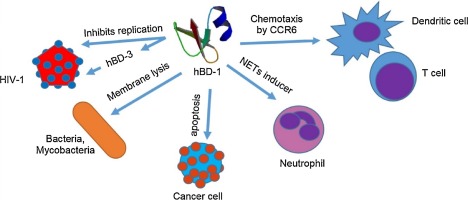What is DEFB1 protein?
Introduction to DEFB1 Protein
The human beta-defensin 1 (DEFB1) protein is an antimicrobial peptide that plays a crucial role in innate immunity against bacterial and viral infections. The discovery of the DEFB1 protein can be attributed to the extensive research on human innate immune system, which led to the identification of various antimicrobial peptides. Exploring the genomic sequences and characterizing the protein-coding genes led scientists to DEFB1 and its unique antimicrobial characteristics.
Background and Gene Locus
The DEFB1 gene, which is responsible for encoding DEFB1 protein, is located within the short arm (p) of chromosome 8 at position 23.1 (8p23.1). Human beta-defensins encompass a gene cluster located in this specific region. The DEFB1 gene, in particular, was one of the first human defensin genes to be identified and characterized in detail. Rare genetic variations in the DEFB1 gene have been associated with a decreased expression of DEFB1 protein in humans, suggesting that DEFB1 plays a critical role in preventing infections and enhancing immune response.
Structure of DEFB1 protein
DEFB1 protein is synthesized as a precursor peptide that gets processed to yield a mature peptide of about 36 amino acids. Structurally, DEFB1 protein comprises six cysteines forming three disulfide bonds, which stabilize the molecule and enable it to resist degradation. The protein reveals a characteristic beta-sheet structure, with three beta-strands constituting the overall shape. The structural rigidity conferred by the disulfide bonds promotes resistance to protease activity, thereby enhancing the stability and effectiveness of the DEFB1 protein in the human body.
Function of DEFB1 protein
DEFB1 protein primarily functions as an antimicrobial agent, exerting a direct antimicrobial activity against a broad spectrum of infectious microorganisms, such as bacteria, fungi, and viruses. It plays a pivotal role in the innate immune system, being expressed in various body surfaces exposed to the external environment, such as the skin and mucosal surfaces. Additionally, DEFB1 stimulates chemotaxis of immune cells, essentially attracting more immune cells to the site of infection and enhancing the overall immune response.

Signal Pathways Related to DEFB1 protein
The signal pathways of DEFB1 protein are crucial for understanding the molecular mechanisms it leverages to confer antimicrobial activity. The primary pathway associated with DEFB1 involves the activation of CCR6, a component of immune cells. DEFB1 induces the migration of CCR6-expressing cells to the infection site, promoting a robust immune response.
DEFB1 Protein Related Diseases
Alterations in DEFB1 protein activity and expression levels have been associated with various diseases. Examples include chronic obstructive pulmonary disease (COPD) and cystic fibrosis, where lower levels of DEFB1 have been observed. Moreover, specific genetic variations within the DEFB1 gene have been linked to periodontitis and susceptibility to HIV-1 infection. Thus, DEFB1 has potential implications in the diagnosis and treatment of these infection-related conditions.
Applications in Biomedicine
Given the crucial role of DEFB1 in the human immune response, it has extensive applications in biomedicine. One major area where DEFB1 can be leveraged is therapeutic development. Given its potent antimicrobial properties, DEFB1 can be co-opted into new therapeutic agents against multi-drug resistant bacteria. Additionally, studying the variants of the DEFB1 gene can provide valuable genetic markers to predict susceptibility to infection or response to certain treatments, aiding in personalized medical strategies.
In conclusion, DEFB1 protein holds immense significance in the human immune system, offering protection against a wide array of microbial invaders. Its unique structure, crucial role in signaling pathways, and application in various disease contexts underline its relevance to biomedical research and the ongoing quest to develop more effective therapies against infectious diseases.
Our Featured Products
| Cat.No. | Product Name | Species | Source (Host) | Tag |
|---|---|---|---|---|
| DEFB1-11929H | Recombinant Human DEFB1, GST-tagged | Human | E.coli | GST |
| DEFB1-455H | Recombinant Human DEFB1 Protein, MYC/DDK-tagged | Human | HEK293 | Myc/DDK |
| DEFB1-653H | Recombinant Human DEFB1 Protein, Fc-tagged | Human | HEK293 | Fc |
| DEFB1-6876H | Recombinant Human DEFB1 protein, His & GST-tagged | Human | E.coli | His/GST |
| DEFB1-2430HF | Recombinant Full Length Human DEFB1 Protein, GST-tagged | Human | In Vitro Cell Free System | GST |
| DEFB1-2300M | Recombinant Mouse DEFB1 Protein, His (Fc)-Avi-tagged | Mouse | HEK293 | His (Fc)-Avi |
| Defb1-2814M | Recombinant Mouse Defb1 protein, His-SUMO-tagged | Mouse | E.coli | His-SUMO |
Reference
- Álvarez, Á. H., Martínez Velázquez, M., & Prado Montes de Oca, E. (2018). Human β-defensin 1 update: Potential clinical applications of the restless warrior. The International Journal of Biochemistry & Cell Biology, 104, 133-137. https://doi.org/10.1016/j.biocel.2018.09.007

